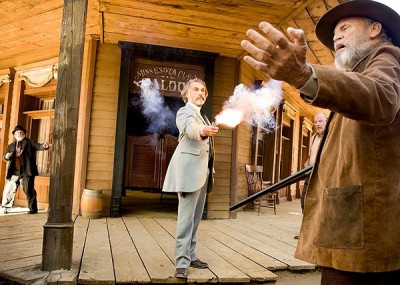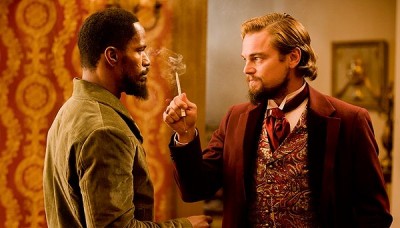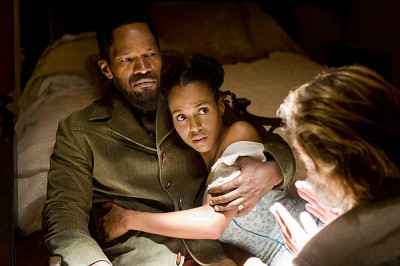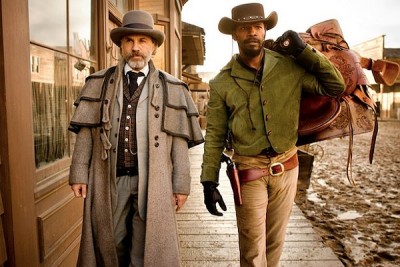
Is Django Unchained over the top? Yes, of course it is. It’s a Quentin Tarantino picture. But is “over the top” a bad thing in the first place? I’d say no. Let’s look at the phrase’s origins. It dates from World War I and originally meant climbing out of the relative safety of the trenches to face the enemy head-on. While I’m not too sure who the enemy is in this case — except maybe the often rather dreary and parochial state of film — I’d be hard pressed not to say that Tarantino long ago (for better or worse) climbed out of the trenches to tackle his own vision of what a movie should be. Yes, that vision is movie geek — or maybe just plain 20th century pop culture geek — to the max. And, no, it doesn’t always work. In the case of Django Unchained — for me at least — it works and then some. Coming at the end of awards season with its procession of heavily respectable movies, I found Django Unchained a bracing dose of unrespectable delight. For pure movie enjoyment — or movie geek (I plead guilty) enjoyment, if you insist — I hadn’t had this much plain fun in a while. And in some ways, the film offers a bit more than that.

Stripped of all its quirks, outrages and digressions — which are the real reason to see the film — Django Unchained is a basic revenge fantasy. That’s to say, it’s your basic Tarantino picture in that regard. It’s the story of an ex-slave, Django (Jamie Foxx), teaming up with German dentist-turned-bounty-hunter, Dr. King Schultz (Christoph Waltz). It turns into an attempt to get Django’s wife, Broomhilda (Kerry Washington), back from decadent plantation owner, Calvin Candie (Leonardo DiCaprio). That’s pretty much it, but that hardly describes this expansive film. What really counts here is the tone of it all, the (often bitter) humor and Tarantino’s increasing mastery of film technique — a mastery that has blessedly made him not one whit less outrageous or (yes) self-indulgent. I don’t consider the term “self-indulgent” a pejorative one — most great art is self-indulgent. But as an approach, it is tricky and doesn’t always pay off (Death Proof, anyone?). Here, it does — in part due to the filmmaker’s sprawling vision of a spaghetti western/exploitation picture of his own.

Tarantino establishes what he’s up to from the start with the mid-1970s Columbia logo, the zoom shots (intelligently limited), the silly “Django” song from the 1966 film Django, etc. No sooner has the 1858 story itself started than we find Dr. King Schultz agreeing to a price for Django by crying, “Sold American!” — a gag probably lifted from Howard Hawks’ His Girl Friday (1940) and derived from the 1930s Lucky Strike (American Tobacco Co.) tobacco auctioneer ads that ended with “Sold American.” By now, it should be clear that the movie has been stylized out of any resemblance to normal historical authenticity. I’d think that goes without saying from a guy whose last picture showed Adolf Hitler machine-gunned to death in a blazing movie theater, but then probably not since all sorts of debate has cropped up about whether “Mandingo fighting” ever existed and if the use of the “N-word” is historically accurate. I’m not sure the first matters (it works in Tarantino’s fantasia concept) and the second — while likely having as much to do with Blazing Saddles (1974) as anything else — can be answered by reading Huckleberry Finn.

The truth is that Tarantino is after a different kind of realism — a visceral, hyperrealism built on shocking us into paying attention, while amusing us with dark humor and the (probably not far from accurate) idea that evil is often stupid and buffoon-like. Sure, it’s funny — in a Blazing Saddles manner — to encounter a generally inept band of would-be Klansmen endlessly bitching about not being able to see out of the eye-holes of their hoods, but I’m not convinced that it’s even slightly far-fetched. None of this means that the film isn’t going to offend — even appall — some people, and that’s not a bad thing. Similarly, I doubt even the geekiest geek will get all the movie references. Oh, things like the screen-high word “MISSISSIPPI” moving across the screen like the opening credit on Gone With the Wind is pretty obvious, but a lot of it is more esoteric. The trick is that the film works whether or not you get all the references — though it probably works on a different level if you do. I didn’t get all of them by any means, but I still had a great time and am calling it a must-see. Will it upset you? Possibly, but that’s part of the point. Rated R for strong graphic violence throughout, a vicious fight, language and some nudity.
Playing at Carolina Asheville Cinema 14, Epic of Hendersonville, Regal Biltmore Grande, United Artists Beaucatcher Cinema 7




Quentin gave the world a delightful gift for Christmas in 97 — that was Jackie Brown. It would become my favourite Tarantino movie. Fifteen years later, Quentin gives us another Christmas present, Django Unchained,Jackie Brown for top spot. I could even see Django entering my top ten favorite movies, but we must give that time. For now, let us just say Tarantino has secured his position as one of my favorite directors.
The opening scenes do a great job of of setting up what you’re about to get into: The movies sense of humor when we are introduced to Dr. King Schultz. The movies sense of danger and tension with his exchange with the two slave drivers. Then, when a horse is shot in the neck and the bloody effect is so extreme, so over-the-top, and so theatrical, you get the sense that this movie is going to command a lot of OH SHIT moments.
For the first good bit of the film, everything plays out like the ultimate guy movie. Two men roaming around the wild, collecting bounties, and trading stories around the campfire, plotting on how to get that woman you love back. And I enjoyed how Schultzs and Djangos friendship during these scenes develops into this subtle father and son relationship. There is something really endearing and fun in watching these two interact.
As fun as the bounty hunting seems, it’s a dirty business, and things deepen greatly when we get to Calvin Candie (Leonardo DeCaprio impresses yet again) in the second half of the film. The fight scene during this introduction is BRUTAL. It is so uncomfortable that I was very tempted to look away with half of the theatre audience. From this scene on, there is an underlying intensity that I haven’t experienced since No Country For Old Men. Nothing feels safe, we are all in danger waiting for that levee to break, waiting for this dance with the devil to shattered and rage in hell’s fire. And OH SHIT when it does.
Two hours and forty-five minutes is a long time spent with any movie, and very few accomplish making that runtime fly by. The Hobbit didn’t, this does. What is even more remarkable is that its the first time I’ve spent with a Tarantino movie that works on such a brisk pace. Past films have always been deliberately talky and lounge like, this one not so much. Django Unchained is two hours and forty-five minutes of pure exhilaration and urgency. It’s as if this is the last film Tarantino will ever make, and he has something to prove. He does.
Now if you’ll excuse me, I have to write a letter —
Dear Christoph Waltz,
I love you. You are truly the heart of this movie.
Rock N Roll Forever,
Scott
I pretty much agree with you overall…except for one thing. Try as I may, I do not get the enthusiasm over Jackie Brown. I have taken three stabs at just sitting through it and each time my attention wanders.
I completely agree; I just could not really LIKE that movie, although I certainly did try. It just didn’t do it for me. It’s the only Tarantino film that I view that way.
The last 30 minutes of this thing were so over the top and had so many unnecessary scenes that the lights in the theater literally came on and stayed on for at least the last 20 minutes of the film.
Regardless of how you feel about the film, none of the faults you seem to perceive would have any bearing on the house lights. Do you really believe that they did?
Try as I may, I do not get the enthusiasm over Jackie Brown.
Well I have a thing for Pam Grier.
I see. Critical standards.
I completely agree; I just could not really LIKE that movie, although I certainly did try. It just didn’t do it for me. It’s the only Tarantino film that I view that way.
I don’t care for Reservoir Dogs or Death Proof either, and Pulp Fiction seems more a clever screenplay than all that much of a movie to me (QT didn’t really start to engage me stylistically till the Kill Bill movies). But I made it through those (Death Proof was in a theater and I was reviewing it, so it had an edge there). Jackie Brown just hasn’t managed to hold my interest.
I had no problem with Reservoir Dogs, although I wasn’t as wowed by it as others seemed to be; I never saw Death Proof (but I have seen Planet Terror 3 or 4 times), so cannot comment on it.
Funny, but while I really enjoyed Pulp Fiction when I saw it at the theater, I’ve had the DVD for several years now and have yet to open it and re-watch the movie. Maybe that’s another way of saying the same thing you did.
For me Death Proof remains the only Tarantino film in which I felt that a single viewing was plenty. Within my particular social circle during my high school years it was more or less mandatory to over-state the merits of Reservoir Dogs to the point that I’m still sorting out how I actually feel about the film. (And since it’s been at least 6 years since I’ve actually sat down with the movie, I haven’t actually made much progress, though I can say it no longer resides on the same tier as Pulp Fiction.) Pulp Fiction still impresses the hell out of me in terms of Tarantino’s ability to craft individual scenes– and even now there’s still enough freshness to it all that it makes for an engaging movie as a whole- though I agree that it’s not until Kill Bill that QT really puts everything together and becomes a full-fledged force in movie making.
As for Jackie Brown, while it feels a little bit uneven at times and is probably a bit over-long, I like the story itself and the characters enough that it works for me, not just as a Tarantino film, but as a movie, full-stop.
Django didn’t feel quite as magnificent as Inglorious Basterds -or not upon one viewing, anyhow- but I think it comes close. And, “I’m positive he’s dead.” struck me as the funniest punchline in all of Tarantino’s repertoire.
For me, it’s that Django lacks anything as amazing and intricate as the theater scenes, but it kind of makes up for that by being an otherwise smoother ride. Now, how that stacks up with the passage of time remains to be seen. I am quite sure that part of my reaction that it’s so cheeky in the face of having recently slogged my way through so many self-serious, self-important awards season movies.
You could tell Sally Menke’s presence was missing from Django, i still would have rather seen Michael K Williams as Django too.
Yes, well…
Well i guess we’ve still got 12 years a slave coming out.
Yes, well…
Well it probably will be better and it has Michael K Williams in it too.
Jeez. DEATH PROOF was flat out boring. I’m glad I saw it before PLANET TERROR or it would have doubly sucked. That stupid bar scene goes on forever and ever and Trantino wasn’t nearly as clever as he thought he was. JACKIE BROWN was okay, nothing great about it but it didn’t bore me. Well, Pam Grier never bores me. KILL BIIL.. .well great. I’ve liked most of Tarantino’s stuff I just don’t think he’s as great as a lot of people do.
Robert Rodriguez does Tarantino better than Tarantino IMHO.
DEATH PROOF was flat out boring. I’m glad I saw it before PLANET TERROR or it would have doubly sucked. That stupid bar scene goes on forever
You know something has gone terribly terribly wrong when you put a T. Rex song in a scene and still can’t win me over.
I’ve liked most of Tarantino’s stuff I just don’t think he’s as great as a lot of people do.
Leaving the dismal Death Proof out of the mix, I think the films from Kill Bill on go a long way toward justifying the reputation he’d (to me) undeservedly obtained.
Well it probably will be better and it has Michael K Williams in it too
Yes, well…
Jeff Lebowski – “Well YEAH”
I might have known,
a generally inept band of would-be Klansmen endlessly bitching about not being able to see out of the eye-holes of their hoods
That scene felt incredibly Pythonesque to me, and not in a bad way.
My only problems with this movie are that it has two second acts and two third acts. Otherwise, I adored it unreservedly.
For me, this was the most fun and focused picture Tarantino has made since JACKIE BROWN.
My only problems with this movie are that it has two second acts and two third acts.
Twice the pleasure in one movie.
Jackie Brown, huh?
Twice the pleasure in one movie.
I consider acts non-repeatable phenomena within a single movie. For example, RETURN OF THE KING has about seven third acts, and is not looked kindly upon for that reason.
And yes, JACKIE BROWN. I’m one of those people.
I consider acts non-repeatable phenomena within a single movie. For example, RETURN OF THE KING has about seven third acts, and is not looked kindly upon for that reason.
I disagree on both counts. It has about seven tag scenes, not actual acts. (Though I’m not keen on this theater term being applied to movies in the first place.)
And yes, JACKIE BROWN. I’m one of those people.
If I ever make it all the way throught — an increasingly dim prospect — I’ll seriously argue the point, but it mostly bores me. Not Death Proof level, mind you, but bores me all the same.
I disagree on both counts. It has about seven tag scenes, not actual acts. (Though I’m not keen on this theater term being applied to movies in the first place.)
Yes, that was perhaps a hasty comparison. It really has seven denouement (does the plural of that have an s on the end or not?).
DJANGO has two climaxes. You should, by definition, only have one climax. The whole film builds toward a climax. You should probably not have a climax, a denouement, then another climax, which is what it felt like to me here.
Whether you want to call them acts or not, it’s really just basic story structure and works across film, theatre, novels, comic books, radio plays and television.
Act 1 – Protagonist is shaken out of his/her normal existence and commits to a goal.
Act 2 – Protagonist pursues this goal through increasing levels of antagonism.
Act 3 – Protagonist accomplishes (or not) their goal in the climax, which is the culmination of the events of the first two acts. Then there’s a denouement to let the audience breathe out for a moment, then the credits.
I don’t think there’s anything theatre specific to this paradigm. In fact, I find movies generally better structured than plays.
I;m of the opinion that a movie should be what it wants to be — as long as it can pull it off. For me, this does. But I am much less worried about structure than you are.
I’m of the opinion that a movie should be what it wants to be — as long as it can pull it off. For me, this does.
I’ve yet to see a movie that departed from traditional story structure that I don’t think would’ve been more satisfying had it stuck with traditional structure.
It worked for BROKEBACK MOUNTAIN, AUSTIN POWERS, GROUNDHOG DAY, INCEPTION, JUNO, TINKER TAILOR SOLDIER SPY, ARGO, REAR WINDOW, MONTY PYTHON AND THE HOLY GRAIL, O BROTHER WHERE ART THOU, MIDNIGHT MEAT TRAIN, OCEAN’S ELEVEN, THE GHOST WRITER, GOOD NIGHT AND GOOD LUCK, DRIVE, etc.
I don’t think this even departs from traditional structure so much as repeat a step, which blunts its impact.
I hope I’m not giving the impression that I have any huge problems with this movie. I think it’s brilliant. Chop 15 minutes out and I think it’s pretty much perfect.
It worked for BROKEBACK MOUNTAIN, AUSTIN POWERS, GROUNDHOG DAY, INCEPTION, JUNO, TINKER TAILOR SOLDIER SPY, ARGO, REAR WINDOW, MONTY PYTHON AND THE HOLY GRAIL, O BROTHER WHERE ART THOU, MIDNIGHT MEAT TRAIN, OCEAN’S ELEVEN, THE GHOST WRITER, GOOD NIGHT AND GOOD LUCK, DRIVE, etc.
You’re going to have to explain what worked, since I’m unclear whether you’re saying these depart from a traditional structure or adhere to it. (I wouldn’t mind knowing how they depart, if that’s what you’re saying, since they don’t all have or lack what you call denouements — a broader definition of the term than the one I learned 40-odd years ago.)
I don’t even think that Django repeats a step. It simply has a climax on top of a climax. And the second one is clearly bigger, so it strikes me as the real third act, if you will.
You’re going to have to explain what worked, since I’m unclear whether you’re saying these depart from a traditional structure or adhere to it.
Sorry, should’ve been clearer. I meant traditional story structure was intact in a group of films as diverse as that.
I don’t even think that Django repeats a step. It simply has a climax on top of a climax. And the second one is clearly bigger, so it strikes me as the real third act, if you will.
It’s a little bigger, but it’s essentially the same sequence, except Django wins and he blows the house up at the end. The whole capture and interlude with the Australians serves little purpose except to extend the movie by ten minutes. If Tarantino had chopped everything out of the film between when the first Candiland firefight starts going against Django and when he takes out Walton Goggins in the second Candiland firefight, I think end would’ve been more satisfying, because it released the tension that had built up so perfectly during the Candiland sequence in one sequence instead of two.
Sorry, should’ve been clearer. I meant traditional story structure was intact in a group of films as diverse as that.
Monty Python and the Holy Grail has a traditional structure? It doesn’t even have a proper ending! And it — and THE GHOST WRITER, for starters — don’t have that breather tag scene you seem to think is essential.
But Monty Python and the Holy Grail does have great credits! I do have to agree about it’s structure and ending. I don’t know if it was Gilliam or Jones that directed the ending, but Gilliam did such a great job with the ending of TIME BANDITS.
Monty Python and the Holy Grail has a traditional structure? It doesn’t even have a proper ending!
Act 1 – King Arthur and his knights are trundling along. God appears and charges them to find the Holy Grail.
Act 2 – King Arthur and his knights pursue the Holy Grail through increasing levels of antagonism
Act 3 – Just as the knights are about to storm the castle and seize the grail, the police show up and arrest them.
Sounds pretty traditional to me.
THE GHOST WRITER, for starters — don’t have that breather tag scene you seem to think is essential.
THE GHOST WRITER, for starters — don’t have that breather tag scene you seem to think is essential.
Yeah, that was probably a mistake to include that as a integral part of story structure. I do think that it’s advisable though, unless the climax is meant to turn on a sudden shock moment and you don’t want the audience to recover from it (ala GHOST WRITER and HOLY GRAIL).
Sounds pretty traditional to me.
Traditional generally doesn’t include subverting the climax.
I do think that it’s advisable though
It has marred more movies than I can count. Starting, recently, with Silver Linings Playbook.
It has marred more movies than I can count. Starting, recently, with Silver Linings Playbook.
I get your objection to the one in OCEAN’S ELEVEN (which has a double denouement problem – and the one at the fountain is clearly better), but I don’t have any problem with the one in SILVER LININGS PLAYBOOK. Had credits rolled at the end of the preceding scene, I would’ve found it a little abrupt.
Double “denouement” (using the corrupted modern definition which seems to mean tag or curtain scene) my ass. That second scene is pure “let’s set up a sequel” crap.
I loathe that final scene on Silver Linings. I neither need, nor want to see everybody making nice nice at the family home. It feels like that scene that comes in between the last commercial break and the credits on a sitcom.